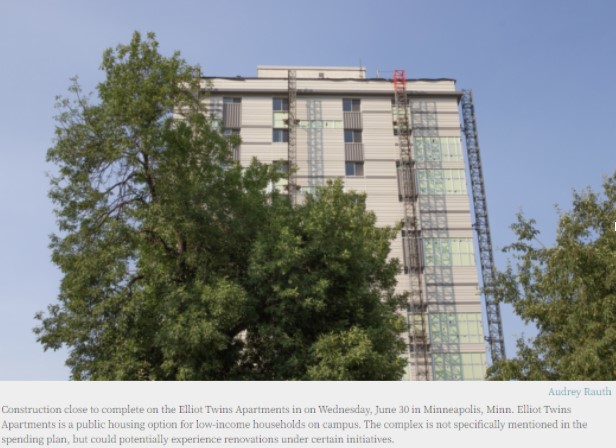On July 2nd, 2021 The Minnesota Daily published an article entitled “Frey proposes $28 million in affordable housing and homelessness”. The article primarily focuses on Jacob Frey’s plan to spend federal funding disbursed from Biden’s American Rescue Plan (ARP) stimulus on several housing initiatives, including the displacement of public housing residents from scattered sites. However, its main photo is of the Elliot Twins Apartments, a former public housing complex not explicitly mentioned in Frey’s plan to use ARP funds. The photo’s caption (shown below along with the photo itself) describes the Elliot Twins as “a public housing option for low-income households on campus” that could “potentially experience renovations under certain initiatives.”
This blurb inadvertently tells the general public something that the Minneapolis Public Housing Authority has long denied: upon its privatization, Elliot Twins will not house public housing residents. This is a subtle change of the official narrative. Despite us calling MPHA’s bluff over a year ago, public officials have repeatedly claimed that public housing residents will continue to live in Elliot Twins.
The story of Elliot Twins’ privatization is long and complicated and involves Minneapolis Councilmembers, MPHA officials, and Mayor Frey himself repeatedly lying to residents. Lies repeated for over four years are finally set straight by this admission in the Minnesota Daily.
The story begins in April 2017, when MPHA submitted to the Department of Housing and Urban Development (HUD) a statement of intent to privatize the Elliot Twins. Specifically, MPHA expressed their interest in using the Rental Assistance Demonstration (RAD) program to convert Elliot Twins from public housing into private housing subsidized through Section 8 vouchers. In early 2018, the Elliot Twins resident council undemocratically and opaquely voted to approve MPHA’s privatization plan, without the acknowledgement or consent of the vast majority of residents.
Upon discovering this, Elliot Twins residents wrote a letter to MPHA disavowing MPHA’s puppet resident council and outlining their grievances with the slow and confusing so-called “relocation plan”. In August 2018, residents met with MPHA Executive Director Greg Russ to convey their opposition to privatization and displacement. Greg Russ responded that displacement would not occur and that during the renovation process residents could use Section 8 vouchers to find housing, ignoring the tight rental market and the long Section 8 waitlist. But there was no guarantee residents would come back after the renovation was complete. In December 2018, Mayor Frey and the City Council passed a resolution to allow MPHA to privatize Minneapolis public housing properties, starting with Elliot Twins. The resolution was authored by Councilmembers Abdi Warsame and Andrea Jenkins without consent or feedback from public housing residents or the general public. The media focused more on the Minneapolis 2040 gentrification plan, which was also approved that same exact day.
In the spring of 2019, Jacob Frey and Greg Russ sent Warsame to stall Elliot Twins residents’ momentum against RAD. Warsame exploited relationships he developed during his previous Ward 6 election to convince some vulnerable elders to stop organizing. Specifically, he promised them no one will be displaced – a boldfaced lie. Shortly after, the City of Minneapolis signed an MOU with MPHA to allow the privatization of public housing without enformentent or protection measures for public housing residents from displacement.
By late 2019, the RAD process was complete. Upon conversion to subsidized private housing, MPHA leased the Elliot Twins’ land to the Royal Bank of Canada for 99 years, effectively selling off the buildings and giving the private sector the ability to make the renovations. Despite being a private financial firm, The Royal Bank of Canada still received over $18 million in public funding in the form of Low Income Housing Tax Credits (LIHTC). Despite this, MPHA claims to maintain control of the buildings through questionable private shell companies, which have taken on large risky loans in order to renovate the buildings. RAD did not save taxpayers any money. The only difference is that now private financiers, developers, and landlords get a cut.
The cosmetic renovations financed by the Royal Bank of Canada and other private financial firms, yet actually funded by the general public’s tax dollars illustrate MPHA’s apparent desire to attract a new type of tenant. The destruction of Minneapolis’ public housing is part of the city government’s broader campaign to attract wealthier and young majority white people to downtown neighborhoods to increase their tax base. By contrast, the long-term residents of Elliot Twins are majority Black and Brown people, seniors, and people with disabilities who receive $750 a month from SSI. The fact that MPHA is apparently marketing these apartments to University of Minnesota students (despite their distance from campus), further demonstrates that long-time public housing residents are not a part of MPHA’s vision for the future of these properties. In order to rent to University of Minnesota students, MPHA and the Elliot Twins’ new owners will have to permanently displace public housing residents. Now that MPHA and City of Minneapolis have effectively acknowledged their real plans to the Minnesota Daily, they have finally exposed their utter disregard for public housing residents and their true intention for Elliot Twins. This is what RAD displacement and destruction of public housing looks like.

